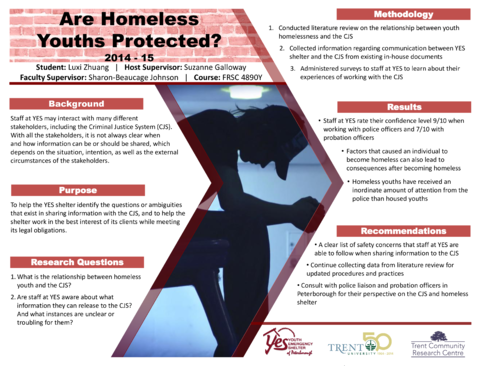English
Fostering Stewardship: Developing an Environmental Framework for Children and Youth in the Greater Peterborough Region
This document makes recommendations to environmental educators in the GPA on how best to generate interest in environmental education in children and youth. In order to do this successfully, professional and personal opinions are considered. The recommendation's bases are formed by a marriage of these two different, yet equally valid perspectives.
Education and Outreach at Local Organic Farm - Project 1 [poster]
The Experience of Peterborough Residents With the Peterborough Renovates Program and the Homeownership Assistance Loan Program
The following research paper investigates the effects of two of Peterborough City and County's affordable housing programs: the Peterborough Renovates Program and the Homebuyer Assistance Loan Program. The goal of the research was to determine whether the programs were meeting their objectives, which were, primarily, positively impacting the quality of life of participants. Additional data about how participants heard about the program and whether they understood the terms of their loan were also collected. To determine whether the programs were meeting their goals both a quantitative and qualitative analyses were performed using data from a survey mailed to participants in both programs. The researchers found the programs do have a positive impact on self- reported quality of life of participants. However, future research into these phenomena is still needed in order to provide specific policy recommendations.
Education and Outreach at Local Organic Farm - Project 1
Cafe Producer and Supplier Profiles [poster]
Sexual Assault Prevention Education for Boys and Male Youth [poster]
YES Shelter for Youth and Families: Communication Protocols Part 2 [poster]
YES Shelter for Youth and Families: Communication Protocols Part 2
The aim of the present project was to identify the questions or ambiguities that concern the staff members of the YES Shelter for Youth and Families regarding the sharing of personal information of youth clients with law enforcement agencies. To accomplish this, the relationship between homeless youth and the criminal justice system was initially researched through journal articles within the past five years to determine why homelessness can lead to criminal behaviour and why homeless youth potentially receive more attention from police. Current policies and procedures from the YES Shelter were also reviewed for ambiguities when sharing information with law enforcement. Survey question were administered to YES staff regarding the release of client information when communicating with police and probation officers. Research through a literature review identified numerous factors leading to homeless youth becoming involved in criminality, such as drug use. In addition, homeless youth often receive extensive attention from police whether they are criminally involved or not, because they are often socially profiled as "dangerous" by the public. Survey responses from YES staff showed a high and consistent level of confidence when releasing client information to the police; however the confidence level when sharing client information with probation officers was low and inconsistent. Overall, youth clients at the YES Shelter felt that their privacy was secured and protected. The research gathered from the present project aims to help the YES Shelter create privacy policies for their staff. Lastly, a list of recommendations was suggested for future research.
Volunteer Program Development [poster]
How Did the Turtle Cross the Road: A Turtle Road Mortality and Mitigation Study
The purpose of the present research was to identify areas of high turtle road mortality, known as hotspots, in order to determine what steps can be taken to help reduce the number of endangered turtle species killed on Ontario roadways. The project was completed by collecting data on turtle locations and using ArcGIS mapping software, by Esri, to determine hotspot locations along a specific highway in Ontario. Once hotspots were determined, examination of literature was conducted to determine the best way to prevent road mortality. Finally, individuals from government and non-for-profit organizations focused on turtle road mortality were interviewed to help determine what is a realistic plan to combat turtle road mortality. In the area of focus, 4 hotspot locations were observed, and the most effective mitigation measures were determined to be a combination of a culvert and a drift fence. In terms of implementation, the jurisdiction over a roadway and whether mitigation measures will be put into place belongs to the proper road authority. However, when road construction impacts an endangered species, the Ministry of Natural Resources and Forestry can enforce, under the Ontario Endangered Species Act, the road authority to implement mitigation measures. Throughout this project, areas for future research such as improving communication between groups involved in turtle road mortality, were also identified and noted.









